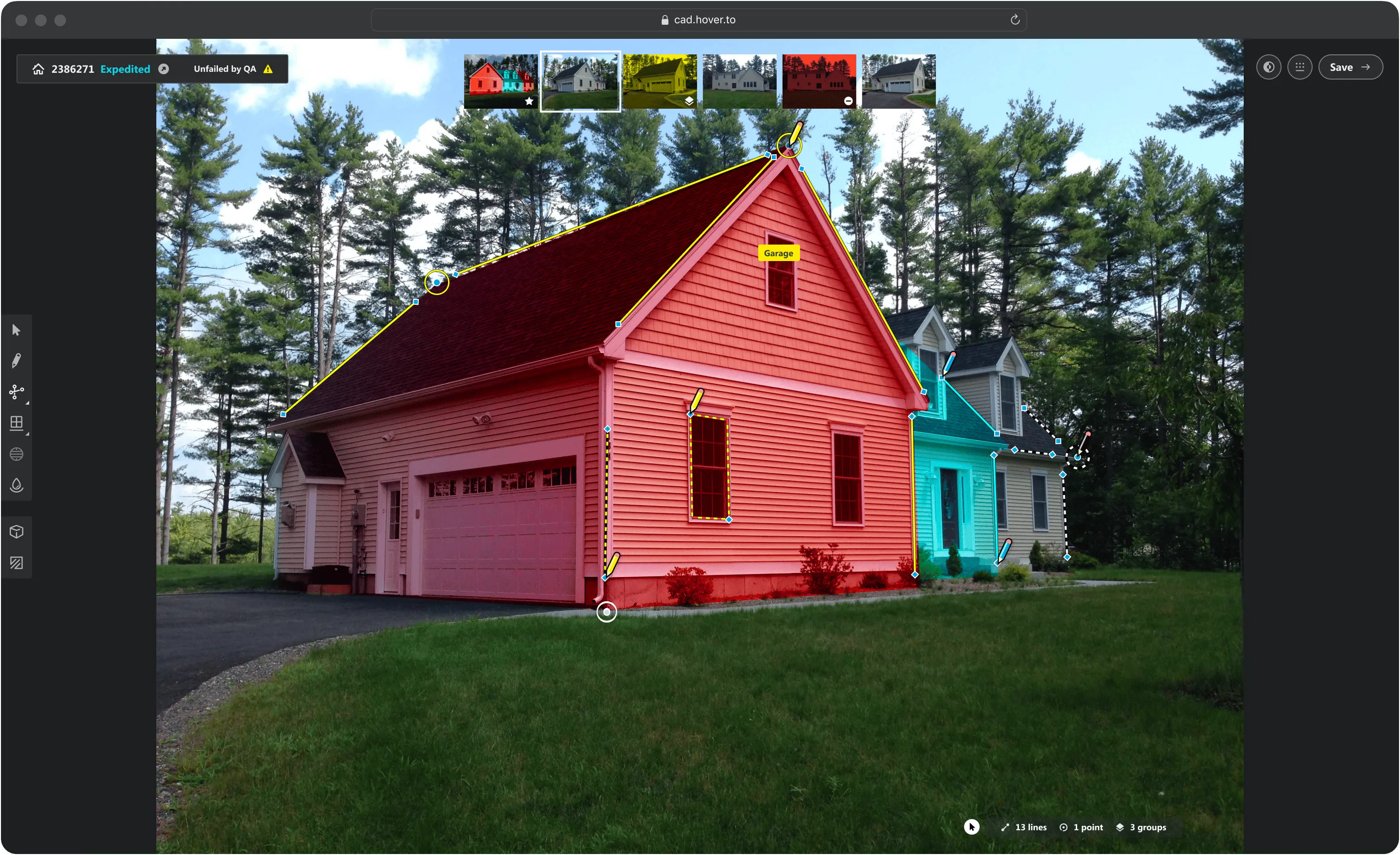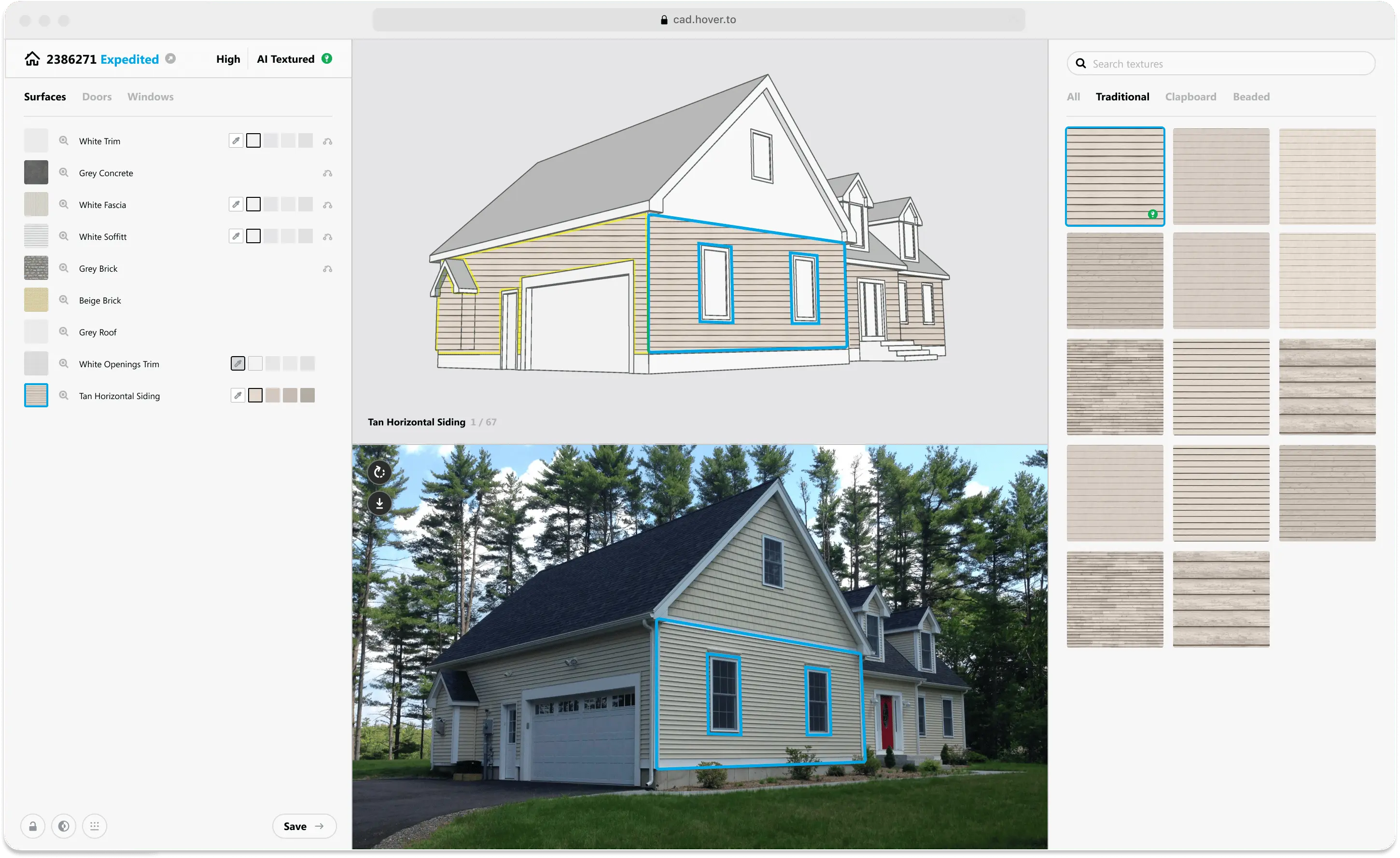Collaborators
FE / Kerry Gould
FE / Colin Parsons
FE / Dustin Baxter
BE / Jacob Burkhart
AI / Jenna Dzitsiuk
AI / Raymond Chow
AI / Giri Murali
PM / Sumeet Howe
FE / Colin Parsons
FE / Dustin Baxter
BE / Jacob Burkhart
AI / Jenna Dzitsiuk
AI / Raymond Chow
AI / Giri Murali
PM / Sumeet Howe
2016—2022
hover.to
→
When I joined Hover, it took 2 hours to model a user’s home. This delay severely
limited our potential userbase. Our team was tasked with reimagining the modeling workflow from scratch in
the pursuit of faster turnaround. The moonshot goal was 1 hour.
What we built was HoverCAD, and by year two we were producing models in under 30 minutes. Hover’s core product transitioned from loss-leader to profit center along the way.
We channeled user-testing and a growing AI team into hyper-focused tooling. Everything built for purpose and assisted by AI where it made sense.
What we built was HoverCAD, and by year two we were producing models in under 30 minutes. Hover’s core product transitioned from loss-leader to profit center along the way.
We channeled user-testing and a growing AI team into hyper-focused tooling. Everything built for purpose and assisted by AI where it made sense.
1
2
3
4
2
3
4
Layers and visualization controls
Vanishing point editor
Facade styling
AI shape builder & dark mode
Vanishing point editor
Facade styling
AI shape builder & dark mode
Nail the Basics
We built & maintained a React-based design system from the very beginning. This
covered common elements, 3D visualization, interaction design, and a custom icon suite. Colors had to work
over photography from any climate in any season.
We also piloted regular user-testing at Hover, setting up remote testing rigs for our users to run structured studies every two weeks. Several times a year we shadowed users on location to collect the unspoken feedback.
We also piloted regular user-testing at Hover, setting up remote testing rigs for our users to run structured studies every two weeks. Several times a year we shadowed users on location to collect the unspoken feedback.
HoverCAD design system on Figma
→
1
2
3
2
3
Window tool selection
Outlining window with cursor
Finishing with styling panel
Outlining window with cursor
Finishing with styling panel
More Focused Tooling
Early gains came from parametric modeling. We studied how our users draw an object in
open CAD, then reduced that process to it's core steps.
Windows, for example. Drawing from scratch with lines and rectangles is tedious. But the process is suprisingly organized.
Our tool progresses from general (what shape?) to specific (how many panes?) without interruption. Once the first window is drawn, others on the same house are easy. Just duplicate, tweak a parameter or two without disrupting the others. SketchUp could never.
A single window was once 5 minutes of work, now completed inside 30 seconds.
Windows, for example. Drawing from scratch with lines and rectangles is tedious. But the process is suprisingly organized.
Our tool progresses from general (what shape?) to specific (how many panes?) without interruption. Once the first window is drawn, others on the same house are easy. Just duplicate, tweak a parameter or two without disrupting the others. SketchUp could never.
A single window was once 5 minutes of work, now completed inside 30 seconds.


1
2
3
2
3
Smart gutters, 2 clicks for each eave
AI markups / primitive creation
CV material texturing
AI markups / primitive creation
CV material texturing
Automation (Where it Helps)
Hover has a deep dataset of residential models, usefully segmented by feature,
material, color, and other metadata. We have location, climate, material preferences for the region. We
looked for ways to inject helpful automation.
Gutters was one target. We based the tool on IBC building code. A gutter can be added to any eave with a single click. Every eave requires a downspout, so the second click places that. The downspout ray-traces to the next roof surface or ground, whichever it hits first.
Textures was another. CV can see board & batten siding and take a guess at the color. ML adjusts suggestions over time depending on our modeler's edits.
We adopted a success threshold for these tools: if the user overrides more than 20% of the time, we're not helping.
Gutters was one target. We based the tool on IBC building code. A gutter can be added to any eave with a single click. Every eave requires a downspout, so the second click places that. The downspout ray-traces to the next roof surface or ground, whichever it hits first.
Textures was another. CV can see board & batten siding and take a guess at the color. ML adjusts suggestions over time depending on our modeler's edits.
We adopted a success threshold for these tools: if the user overrides more than 20% of the time, we're not helping.